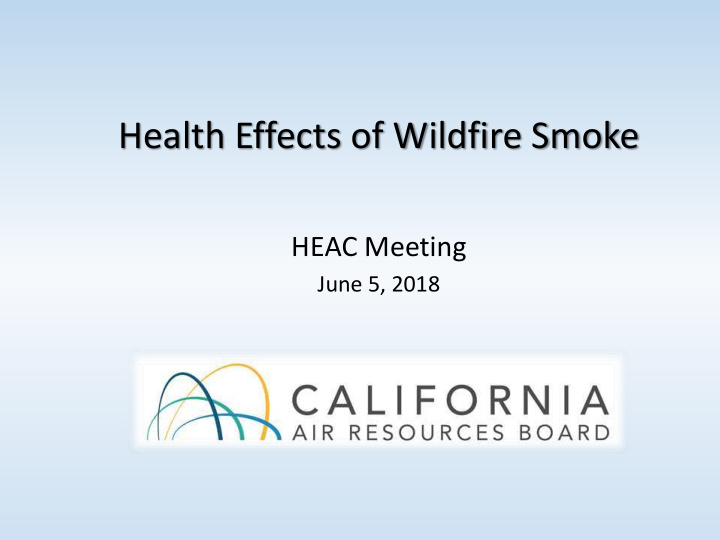



Health Effects of Wildfire Smoke HEAC Meeting June 5, 2018
Outline • Health Effects of Particulate Air Pollution • Ambient Air Quality Standards • Wildfire Smoke Guidance • Wildfire-related Research in California 2
Health Effects of PM2.5 Exposure • Premature death • Causal for cardiopulmonary disease (US EPA) • Hospital admissions for worsening of respiratory and cardiac disease • Emergency room visits for asthma • Reduced lung function in children • Increased risk of bronchitis and chronic cough • Exposure during pregnancy – low birth weight, premature birth, and birth defects 3
Populations Most at Risk: PM2.5 • Older adults • People with chronic heart or lung disease • Children • Estimated annual health impacts in California • 7,200 premature deaths • 1,900 hospitalizations • 5,200 ER visits for asthma 4
Ambient Air Quality Standards (AAQS) • Clean Air Act requires the US EPA to set NAAQS "with an adequate margin of safety…to protect human health” • Also mandated in California (CAAQS) • NAAQS and CAAQS based only on health considerations • Zero risk not required • Penalties for failure to attain NAAQS by target date 5
Current Standards: CAAQS and NAAQS Pollutant NAAQS CAAQS Averaging Time PM2.5 12 µg/m 3 12 µg/m 3 Annual 35 µg/m 3 -- 24-hour PM10 150 µg/m 3 50 µg/m 3 24-hour -- 20 µg/m 3 Annual Ozone -- 0.09 ppm 1 hour 0.07 ppm 0.07 ppm 8-hour NO 2 0.053 ppm 0.030 ppm Annual 100 ppb 0.18 ppm 1-hour SO 2 0.14 ppm 0.04 ppm 24-hour 0.03 ppm -- Annual Carbon 35 ppm 20 ppm 1-hour Monoxide 9 ppm 9 ppm 8-hour Lead 0.15 µg/m 3 1.5 µg/m 3 Rolling 3-mo avg 30-d avg 6
Area Designations for CAAQS for PM2.5 Unclassified Attainment Nonattainment 7
Wildfire Smoke Guidance 8
Recommended Actions for Public Health Officials AQI Category PM2.5 (AQI Values) µg/m3 Recommended Actions 24-hr avg •If smoke event forecast, implement communication plan Good 0-12 (0 to 50) •Prepare for full implementation of School Activity Guidelines (http://www3.epa.gov/airnow/flag/school-chart-2014.pdf) Moderate 12.1-35.4 •Issue public service announcements (PSAs) advising public about health effects, (51 to 100) symptoms and ways to reduce exposure •Distribute information about exposure avoidance •Evaluate Implementation of School Activity Guidelines Unhealthy for 35.5-55.4 •If smoke event projected to be prolonged, evaluate and notify possible sites for cleaner Sensitive Groups air shelters (101 to 150) •If smoke event projected to be prolonged, prepare evacuation plans •Full implementation of School Activity Guidelines Unhealthy 55.5-150.4 •Consider canceling outdoor events (e.g., concerts and competitive sports), based on (151 to 200) public health and travel considerations. •Schools move all activities indoors or reschedule them to another day. Very Unhealthy 150.5-250.4 •Consider closing some or all schools (201 to 300) •Cancel outdoor events involving activity (e.g., competitive sports) •Consider canceling outdoor events that do not involve activity (e.g. concerts) •Consider closing schools Hazardous >250.5-500 •Cancel outdoor events (e.g. , concerts and competitive sports (>300) •Consider closing workplaces not essential to public health •If PM level is projected to remain high for a prolonged time, consider evacuation of at-risk populations
Wildfire-related Research in California Published Health Studies • A number of epidemiological studies from southern California wildfires (2003, 2007) • Increased respiratory hospital admissions, especially for asthma • For the very young and the elderly • Slight reduced birthweight among infants exposure in utero • Increased eye and respiratory symptoms in children • CARB study on the effects of wood-burning ban in the San Joaquin Air Basin • PM2.5 concentrations decreased 12% after wood-burning ban • Hospitalizations for CVD decreased 7% after wood-burning ban • IHD hospitalizations decreased 16% after wood-burning ban 10
Wildfire-related Research in California CARB-funded Health Studies (Lisa Miller, UC Davis) • Cohort of 50 outdoor colony rhesus monkeys born ~ during Trinity and Humboldt County wildfires (2008) • Impact of early life episodic ozone and PM exposure • Blood and lung tests at age 3 • Early life exposure to ozone and wildfire PM2.5 can result in immune and lung function decrements that persist with maturity • Follow-up study (in progress) • Are adverse health effects from air pollution exposure passed on from mother to child? 11
For More Information Barbara Weller Linda Smith (916)324-4816 (916)327-8225 Barbara.Weller@arb.ca.gov Linda.Smith@arb.ca.gov Research Division 12
Recommend
More recommend